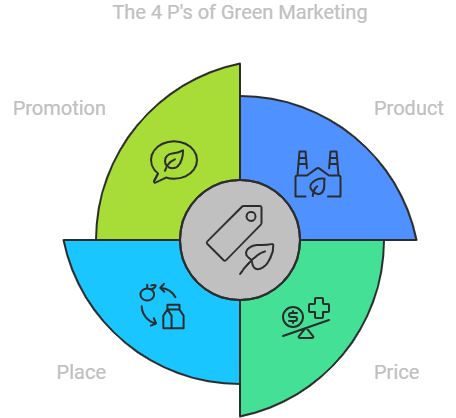Discovering the 4 P’s of Green Marketing
Are you ready to learn about marketing and the four Ps of Green Marketing? Number one is product, number two is price, number three is place, and number four is promotion.
These elements are crucial for successful marketing. They help businesses reach their target audience effectively.
Let’s examine the purpose, history, and breakdown of these four Ps to understand the secrets of green marketing success.
Understanding Green Marketing
What is Green Marketing?
Green marketing involves promoting and selling environmentally friendly products and services. These products aim to improve both individual health and the planet. This type of marketing includes advertising products made from recycled materials, using green chemistry, or designed to lessen environmental harm.
Businesses today find green marketing very important because of the rising awareness of climate change and the need for sustainability. To effectively include green marketing strategies, companies can focus on the product, price, place, promotion, and people aspects. Businesses can align their marketing with environmental values by understanding the target audience’s preferences for green products, adjusting pricing to encourage eco-friendly purchases, choosing sustainable distribution channels, and creating green-focused advertising campaigns.
Moreover, collaborating with similar organizations, following green procedures, and showing physical proof of eco-friendly initiatives are key to forming a robust green marketing strategy. By employing lean innovation and digital marketing tools like social media marketing, businesses can utilize green marketing to attract eco-conscious consumers and stand out in the market.
Importance of Green Marketing
Green marketing is important for businesses today. It focuses on environmental sustainability and health, catering to consumers who prefer eco-friendly options.
Developing green products using recycled materials or energy-saving features is a key part of green marketing. Promoting these products through eco-friendly advertising and venues can attract an audience that cares about the environment.
Green marketing also shows a company’s commitment to sustainability and sets it apart from competitors. This approach considers the impact on the environment and consumer well-being.
Using marketing channels like social media and digital marketing to communicate green practices can help companies reach their target audience effectively.
Incorporating green marketing into the traditional marketing mix improves the overall strategy and helps companies stay relevant in a changing consumer landscape focused on environmental issues.
What are the 4 P’s of Green Marketing?

Product
In Green Marketing, companies focus on developing eco-friendly products through innovation and lean strategies. They create products from recycled materials with energy-saving features and that promote a healthy environment.
Product development is crucial in Green Marketing to meet audience needs and support sustainable practices. It involves considering the product’s environmental impact, using green chemistry, and designing efficient products to minimize harm.
By understanding the five Ps of marketing (product, price, place, promotion, and people), companies can create a successful marketing mix for their green products. Collaborating with partners, using appropriate marketing channels, and considering the 5 Cs (customer, company, competition, collaborators, and climate) can also enhance Green Marketing strategies.
Companies like UNIQLO and Apple have demonstrated successful green marketing approaches through strategic planning, smart advertising, and a focus on environmentally friendly practices.
Price
Effective pricing strategies in green marketing involve setting prices that reflect the value of environmentally friendly products while being accessible to the target audience.
Companies can align pricing with customer expectations and business goals by considering consumer willingness to pay.
Common tactics include competitive pricing, incentives for sustainable choices, and highlighting long-term savings.
Transparent pricing builds trust and reinforces the value of sustainable options.
The pricing strategy in green marketing influences consumer behavior and drives the adoption of eco-friendly products.
Place
Green marketing focuses on where and how sustainable products are made available to consumers.
Businesses select distribution channels that align with the target audience’s values.
This helps promote and sell environmentally friendly products effectively.
UNIQLO is an example. They prioritize sustainable materials and eco-friendly practices in their partner factories.
This approach meets the demand for green products and highlights the influence of green places on consumer behavior.
Considering the impact of “Place” strategies in the marketing mix can enhance overall marketing strategy.
It helps businesses reach their target consumers, contribute to a healthier environment, and appeal to environmentally conscious consumers.
Promotion
Promotion is essential in green marketing. Businesses can attract eco-conscious consumers by using green advertising.
Communication strategies focusing on sustainability and environmental responsibility help showcase a commitment to the environment.
This approach appeals to consumers who value green initiatives.
Uniqlo, for example, is a company known for innovative, high-quality products. They use recycled materials and energy-saving practices.
Their flexible business model allows them to adapt to changing consumer preferences and incorporate lean innovation.
Emphasizing green practices in promotions helps businesses highlight the benefits of eco-friendly products.
This sets them apart in the market and attracts target consumers who prioritize environmentally friendly choices.
Product in Green Marketing
Eco-friendly Product Development
Companies can make their product development process eco-friendly by:
- Innovating in business and adopting a flexible model.
- Using recycled materials and energy-saving features.
- Implementing green chemistry practices from design to production.
To effectively market eco-friendly products, companies should:
- Identify the target audience’s preferences for health and the environment.
- Price products competitively and choose green distribution places.
- Utilize green marketing channels.
Understanding the 5 Cs and seven Ps of marketing helps companies:
- Collaborate with partners and implement sustainable production.
- Consider external factors like climate to reduce harmful effects.
- Conduct strategic planning and competition analysis.
Successful companies like UNIQLO and Apple demonstrate the importance of green product development and marketing in today’s competitive marketplace.
Price in Green Marketing
Value-based Pricing Strategies
Value-based pricing strategies in green marketing consider various factors. These help effectively communicate the value of eco-friendly products to consumers.
Companies must analyze their target audience to understand their willingness to pay for sustainable products. Setting the right price allows businesses to convey quality and benefits while staying competitive.
Placing eco-friendly items in the right channels, like specialty stores or online platforms focused on sustainability, can attract environmentally conscious consumers.
Promotional activities should highlight the unique selling points of green products. These include energy-saving features, the use of recycled materials, and positive impacts on health and the environment.
Innovative pricing strategies and lean innovation in product development help align pricing with the value proposition of green products. This attracts and retains customers who prioritize sustainability in their purchases.
Place in Green Marketing

Distribution Channels for Sustainable Products
Distribution channels for sustainable products play a big role in reaching eco-conscious consumers. Companies must think of new ways to distribute their green products effectively.
They can focus on green channels, such as e-commerce platforms promoting energy-saving practices or retail stores featuring eco-friendly products. This way, businesses can target audiences interested in sustainable options.
Flexibility in the business model is crucial to adapting to the changing landscape of green marketing. Some challenges include competition, pricing strategies, and reaching the right audience. Companies can tackle these hurdles by applying lean innovation, using green marketing channels, and highlighting the advantages of their environmentally friendly products.
Businesses should consider the 5 Cs—collaborating with like-minded partners—when creating successful distribution channels for sustainable products. With strategic planning and aligning with green values, companies can navigate the complex world of green marketing and promote products that benefit both people’s health and the environment.
Promotion in Green Marketing
Green Advertising and Communication Strategies

Green advertising and communication strategies are important for promoting sustainability and environmentally-friendly products.
Emphasizing innovation and using lean innovation practices can help companies develop green products with recycled materials and energy-saving technologies.
These strategies aim to create efficient products with minimal environmental impact and prioritize consumer health.
Reaching the target audience and educating consumers about the benefits of green products are necessary for successful green marketing.
Government regulations and policies also play a role by setting standards for eco-friendly practices and encouraging companies to embrace green strategies.
Integrating green practices into the marketing mix, such as incorporating green places and promotions, can help businesses appeal to environmentally conscious consumers and stand out in the market.
This approach aligns with the 5 Ps and the 5 C principles, focusing on collaboration with partners and adapting to ensure sustainable marketing strategies.
Companies can enhance their marketing skills through platforms like Coursera, especially in social media and digital marketing, to remain competitive in the evolving landscape of green advertising.
Examples of Successful Green Marketing Strategies

Companies like UNIQLO, known for its low-priced, high-quality, and innovative casual wear, can demonstrate successful green marketing strategies. UNIQLO purchases fabric in large volumes, uses top-quality and cost-effective materials from around the world, and has strategic partnerships with Japanese manufacturers.
UNIQLO uses partner factories for production and quality control by skilled textile artisans, showcasing lean innovation in business. They also focus on energy-saving practices and using recycled materials, showing their commitment to green product development. By targeting specific sports stores over general outlets, they effectively reach their environmentally conscious target audience, aligning with the concept of a green place.
In terms of marketing, UNIQLO’s channel choices and media strategy have contributed to its success. By emphasizing the promotional aspect of the marketing mix, UNIQLO has created a brand that resonates with environmentally conscious consumers. This strategy drives engagement and loyalty toward its products, showcasing how a company can effectively implement green marketing for both consumer interest and environmentally friendly initiatives.

Vizologi is a revolutionary AI-generated business strategy tool that offers its users access to advanced features to create and refine start-up ideas quickly.
It generates limitless business ideas, gains insights on markets and competitors, and automates business plan creation.


